No products in the cart.
NEWS
Discover the Ease and Beauty of Growing Plants in Water
Cultivating plants directly in water, often known as hydroponic or aquatic gardening, is a beloved practice among many plant enthusiasts. It’s incredibly easy to get started and offers a refreshing way to decorate any space. Beyond their visual appeal, different water plants can also carry unique meanings and bring a sense of tranquility. As experts at Biogarden.Asia, we’re excited to explore the fascinating world of plants you can grow submerged or with their roots in water.
What Exactly Are Water Plants?
Simply put, water plants, also called aquatic or hydroponic plants in this context, are those cultivated with their roots directly submerged in water instead of soil. The plant absorbs all necessary nutrients directly from this water environment.
Typically, these plants are grown in various water settings such as ponds, aquariums, or increasingly, in small decorative pots or glass containers indoors. Water provides a relatively stable and suitable environment for many species to thrive, provided they receive the right balance of light and nutrients.
The popularity of growing plants in water has soared because it brings a fresh, dynamic feel to living spaces. Many varieties are suitable for small pots, making this form of gardening convenient for homes and offices alike.
10+ Popular Plants Perfect for Water Growing
The diversity of plants suitable for water culture offers endless choices for enhancing your home decor. Each species boasts distinct physical characteristics and growth habits. Let’s explore some popular plants that flourish when grown in water.
Schefflera (Dwarf Umbrella Tree)
The Schefflera, sometimes called the Dwarf Umbrella Tree, is a popular choice for adding a touch of greenery to indoor spaces. Its name references the way its leaves fan out like an umbrella. This plant can be easily transitioned to water culture.
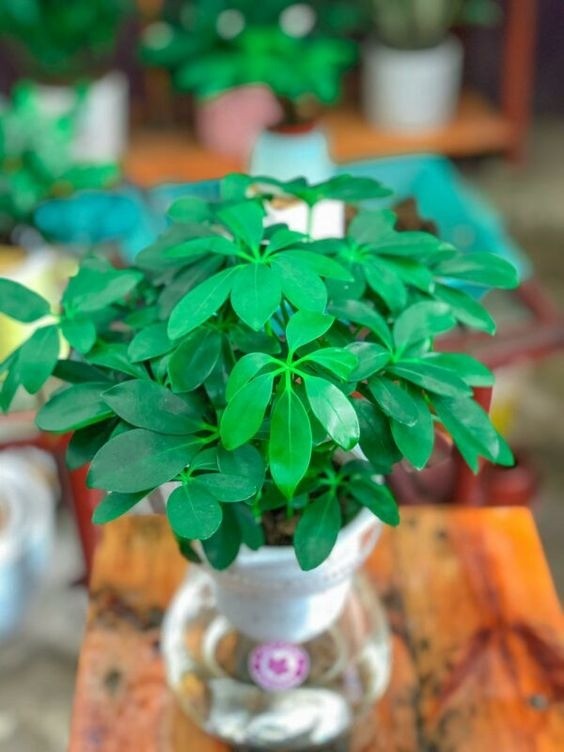 Healthy Schefflera plant thriving with roots submerged in a clear glass vase of water
Healthy Schefflera plant thriving with roots submerged in a clear glass vase of water
Characteristics:
- Often grown as a woody shrub or tree, but young cuttings readily root in water.
- Leaves are compound, with several leaflets radiating from a central point, resembling an umbrella. Leaflets are typically oval or lance-shaped with pointed tips and a fresh green color.
- Can tolerate a range of light conditions, preferring bright, indirect light but adapting to lower light. Avoid direct, harsh sunlight.
- Ideal temperature range for growth is typically between 18-27°C (64-81°F).
ZZ Plant (Zamioculcas zamiifolia)
For those new to growing plants in water, the ZZ Plant is an excellent starting point. Known for its striking appearance and minimal care requirements, the ZZ Plant adapts well to a water environment.
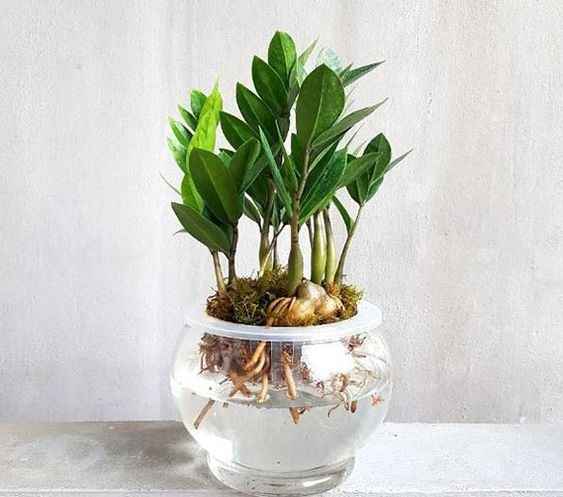 ZZ Plant with dark green, waxy leaves growing in a glass container of water, showing healthy white roots
ZZ Plant with dark green, waxy leaves growing in a glass container of water, showing healthy white roots
Characteristics:
- Features thick, upright stems with pairs of dark green, glossy leaves that contribute to its aesthetic appeal.
- When grown in water, it develops thick white roots that are quite robust and develop vigorously in the aquatic setting.
- ZZ Plants are highly adaptable to different light levels, from low light to bright, indirect light. They are remarkably tolerant.
- Optimal growth occurs in temperatures between 18-27°C (64-81°F).
Aloe Vera
Aloe Vera can be cultivated in water to create an interesting focal point in your living area. It’s an ideal plant for water culture as it’s straightforward to grow and doesn’t demand extensive care techniques.
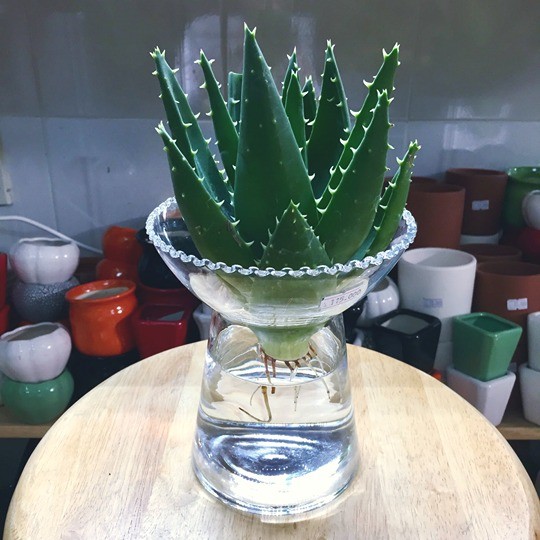 Aloe Vera plant with thick, fleshy, grey-green leaves growing in a small glass pot filled with water
Aloe Vera plant with thick, fleshy, grey-green leaves growing in a small glass pot filled with water
Characteristics:
- Has a short stem and is often grown in water pots or glass jars, lending a refreshing feel to the space.
- Leaves are thick, fleshy, and typically grey-green, long and broad with serrated edges.
- When rooted in water, the root system tends to grow quite long and extensive.
Variegated Philodendron (e.g., ‘White Princess’)
Growing a variegated Philodendron, such as the ‘White Prince’ or ‘White Princess’ variety, in water can bring a unique and captivating look to your space, enhancing its natural beauty and aesthetic appeal.
 Philodendron White Princess with characteristic patterned leaves growing in a glass vase of water
Philodendron White Princess with characteristic patterned leaves growing in a glass vase of water
Characteristics:
- Can be grown as a water plant, with roots developing readily in the water environment.
- Leaves feature distinctive patterns or variegation, often with white or pink markings on a green background, creating a unique and interesting appearance. The shape is typically oval or heart-shaped.
- The variegated patterns give the leaves a unique aesthetic charm.
Lucky Bamboo (Dracaena sanderiana)
Lucky Bamboo grown in water is not just a visually appealing houseplant but is also widely believed to bring good fortune and prosperity. Growing this plant in water can add vitality and a decorative accent to your home.
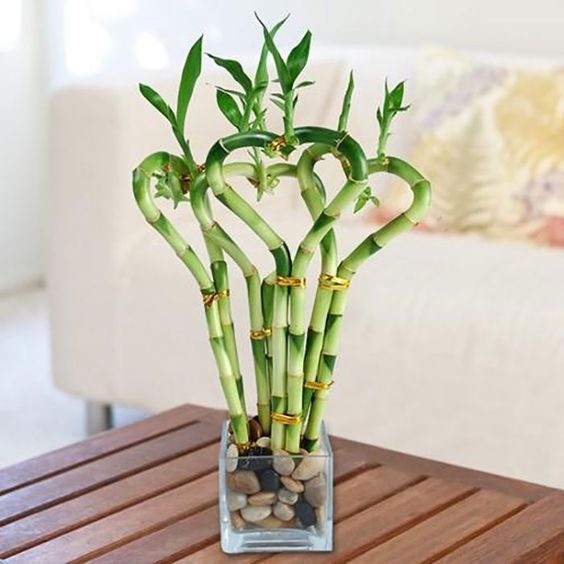 Styled Lucky Bamboo stalks in a glass container filled with water, showcasing the roots
Styled Lucky Bamboo stalks in a glass container filled with water, showcasing the roots
Characteristics:
- Features upright stems that can be styled or bent into various shapes depending on how they are grown.
- Leaves are typically arranged in layers or nodes along the stem, with varying numbers of leaves at each level, creating a unique visual structure.
- Leaves are usually fresh green or dark green, slender and flat.
- The root system grows and spreads widely beneath the water surface.
Pothos (Devil’s Ivy)
Pothos, also known as Devil’s Ivy, is a very popular and easy-to-care-for plant. Pothos grown in water possesses a unique beauty that offers a novel impression.
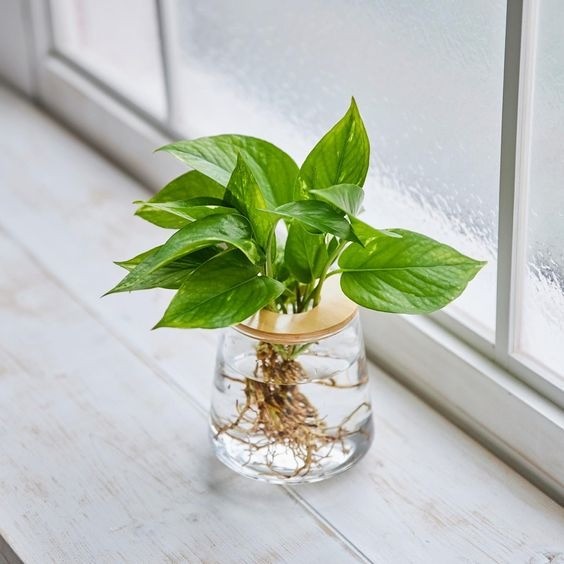 Pothos plant with heart-shaped green leaves growing in a glass jar filled with water
Pothos plant with heart-shaped green leaves growing in a glass jar filled with water
Characteristics:
- Leaves are typically fresh green, heart-shaped or oval.
- Pothos is a vigorous vining plant; its stems and branches can trail along decorative objects or hang down, creating a natural, cascading form.
- Pothos prefers medium to low light conditions.
- Temperatures around 18-27°C (64-81°F) are usually ideal for its growth.
Water Calla Lily (Zantedeschia aethiopica)
The Water Calla Lily is a common aquatic plant in water gardens and freshwater aquariums. This plant typically creates a natural, lush green environment.
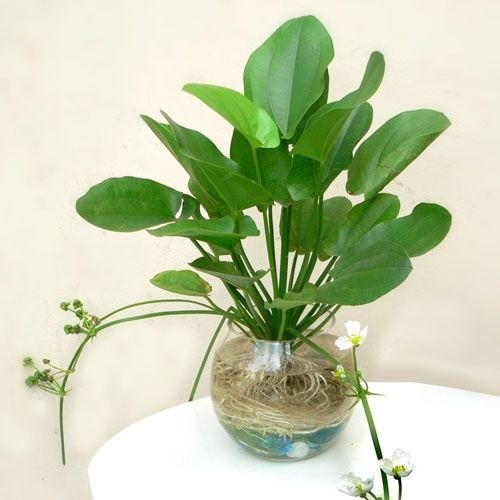 Water Calla Lily plant with broad green leaves and white spathes (flowers) growing in water
Water Calla Lily plant with broad green leaves and white spathes (flowers) growing in water
Characteristics:
- Leaves are usually broad, heart-shaped, or sometimes arrowhead-shaped depending on the variety.
- Leaf color can range from dark green to lighter green, and some varieties have white or red spots or patterns.
- The rhizome (underground stem) is an important part of the plant, helping store nutrients and allowing the plant to recover after pruning.
- Flowers, which are actually modified leaves called spathes, typically emerge above the water surface. The spathes can be white, red, or pink depending on the type.
- The size of the Water Calla Lily can vary from small to large, depending on the variety and growing conditions.
Peace Lily (Spathiphyllum)
A Peace Lily grown in water is not only uniquely beautiful but also signifies elegance and refinement. This popular and attractive type of lily is often cultivated in pots or water containers to add an interesting accent to living spaces.
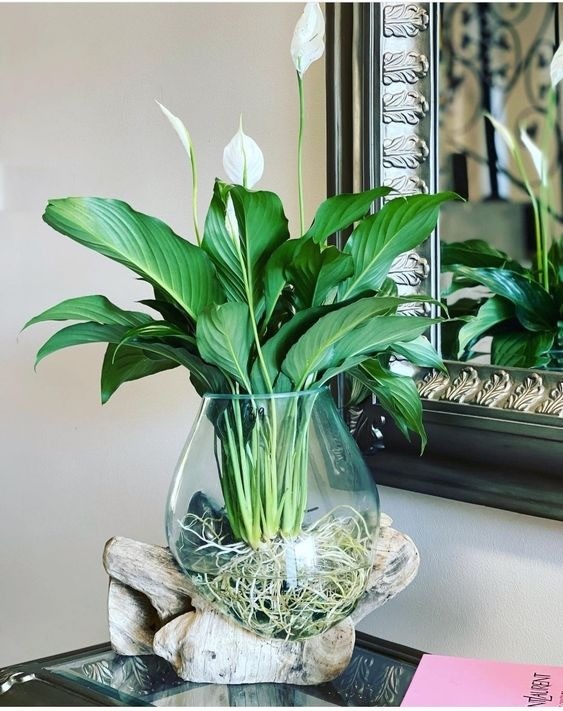 Peace Lily plant with dark green leaves and distinctive white spathes growing in a clear glass vase of water
Peace Lily plant with dark green leaves and distinctive white spathes growing in a clear glass vase of water
Characteristics:
- Leaves are typically dark green to light green, oval or lance-shaped. The leaf surface often has a slight sheen and is smooth.
- The roots are usually grey or silver and are capable of absorbing water and nutrients effectively.
- Peace Lilies typically have long flower stalks, often bearing multiple “flowers” (white spathes with a central spadix) on each stalk.
- The spathes are most commonly white, but cultivated varieties can sometimes show hints of green.
- This plant thrives in low to medium indirect light.
Anthurium
Anthurium brings a touch of softness and freshness to living spaces. With its varied leaf forms and adaptability to different conditions, it’s a popular choice for plant lovers. Some Anthurium varieties can be successfully grown hydroponically.
 Anthurium plant with large green leaves and a red spathe (flower) growing with roots in water
Anthurium plant with large green leaves and a red spathe (flower) growing with roots in water
Characteristics:
- Leaves are usually fresh green, large, and pointed towards the tip, or sometimes heart-shaped, depending on the specific variety.
- The colorful part often mistaken for a flower is a spathe, which is quite beautiful and can be red, pink, orange, or white, often heart-shaped. The true flowers are tiny and found on the central spadix.
- The root system of Anthurium is relatively strong and often appears white when grown in water.
Tulip
Tulips are bulbous flowering plants from the lily family, known for their vibrant and diverse colored blooms that brighten up living spaces. Tulips are symbols of spring, representing fresh beauty and a wide array of colors. While typically grown in soil, tulips can also be “forced” to bloom in water indoors.
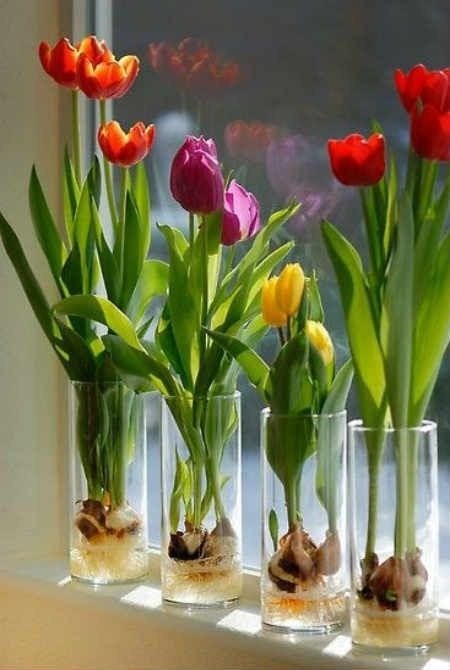 Tulip bulbs being forced to grow in a narrow-necked glass vase with water
Tulip bulbs being forced to grow in a narrow-necked glass vase with water
Characteristics:
- Tulips have upright stems that grow from a bulb underground.
- Leaves are usually strap-shaped and green. Leaves may grow symmetrically or asymmetrically along the stem, depending on the variety.
- Blooms are typically cup-shaped, usually with only one flower per stem.
- Flower colors are incredibly diverse, ranging from white, yellow, red, pink, orange, purple, to many bicolored combinations.
- Tulips have single blooms (one layer of petals) or double blooms (multiple layers of overlapping petals).
- They grow from a brown bulb, typically planted in the autumn to bloom in the spring (or started in water for indoor forcing).
Aglaonema (Chinese Evergreen)
Aglaonema, particularly varieties known for their colorful foliage, can be grown in water. They are cultivated primarily for the beauty of their leaves and their ability to adapt to a water environment. The plant’s physical characteristics create a fresh and appealing look for the living space.
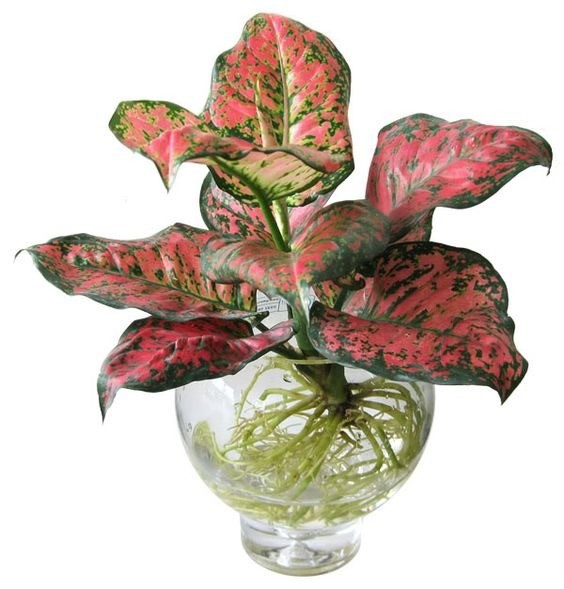 Aglaonema plant with vibrant pink and green patterned leaves growing hydroponically in a glass container
Aglaonema plant with vibrant pink and green patterned leaves growing hydroponically in a glass container
Characteristics:
- Leaves are usually oval or rounded, with pointed or slightly rounded tips.
- Leaf color is a main attraction, often featuring shades of dark pink, light pink, or reddish-orange, depending on the variety and the amount of light the plant receives. Some types have striking patterns.
- Leaves are often smooth and soft to the touch, creating a gentle and very eye-catching appearance.
Hyacinth (Hoa Tiên Ông)
The Hyacinth is a flowering plant often grown for its interesting appearance and captivating fragrance. While typically grown from bulbs in soil, Hyacinth bulbs can be easily forced to bloom indoors in water, creating a unique visual accent.
 Hyacinth bulb suspended in water in a shaped glass vase, showing roots developing below
Hyacinth bulb suspended in water in a shaped glass vase, showing roots developing below
Characteristics:
- Leaves are usually strap-shaped or slightly oval.
- Leaf color is typically dark green or light green, depending on the variety and light conditions.
- Hyacinths are known for their dense spikes of fragrant, star-shaped flowers.
- Flowers come in various colors, such as white, pink, red, purple, and orange.
- The stem grows upright from the bulb, bearing the cluster of flowers at the top.
Important Considerations When Growing Water Plants (Hydroponically)
Growing plants in water can indeed bring a refreshing and attractive focal point to your living space. However, for your plants to thrive and develop vigorously, you need to grasp some essential principles of water culture.
- Choose the Right Plant: Select species specifically suitable for water growing and consider their compatibility with your environment and personal preference. The plants suggested above are among the most popular and well-suited for water culture.
- Select the Appropriate Container: Choose a pot, vase, or container that is suitable for the plant species and your decorative purpose. Ensure it provides adequate space for the roots to grow and spread within the water.
- Provide Good Lighting: Ensure the growing location receives optimal light for the plant to develop. Different plants have different light needs, but most water plants benefit from bright, indirect light.
- Maintain Water Quality & Add Nutrients: The water should be clean and free from pollutants. Regularly replenish or change the water. Critically, since water lacks the nutrients found in soil, you must regularly add liquid hydroponic nutrients specifically formulated for plants grown in water. This is vital for healthy growth.
- Check Water pH: Ensure the water’s pH level is maintained within a suitable range, generally between 6.0 – 7.5, which is ideal for nutrient absorption by the roots.
As experts at Biogarden.Asia, we’ve provided you with a list of popular plants for water growing along with some helpful tips. We hope this information gives you plenty of inspiration for selecting plants to brighten your home decor. Explore our range of gardening solutions and products to support your water gardening journey at Biogarden.Asia.



